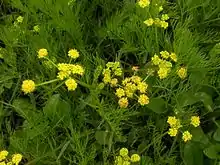Lomatium bradshawii
Lomatium bradshawii, also known as Bradshaw's desert parsley, is an endangered perennial herb native to Oregon and Washington, United States. Lomatium bradshawii was thought to be extinct until 1979, when it was rediscovered by a University of Oregon graduate.[2] This herb was common in the Willamette Valley before agricultural development and fire prevention which has allowed shrubs and weeds to invade. Most known populations of Lomatium bradshawii are within ten miles of Eugene, Oregon. In the Willamette Valley, populations exist in the Oregon counties Lane, Benton, Linn, and Marion, and in Washington Lomatium bradshawii grows in Puget Sound. The largest population of this herb is in Camas Meadows, Washington, with a population of 10,7900,00 +/- 2,010,000,[3] and the Berry Botanic Garden keeps a seedbank.
| Lomatium bradshawii | |
|---|---|
 | |
| Scientific classification | |
| Kingdom: | |
| (unranked): | |
| (unranked): | |
| (unranked): | |
| Order: | |
| Family: | |
| Genus: | |
| Species: | L. bradshawii |
| Binomial name | |
| Lomatium bradshawii | |
| Synonyms[1] | |
| |
Lomatium bradshawii grows in low elevations along rivers or in regularly flooded prairies. Yellow inflorescences of Lomatium bradshawii occur from April to May.[4]
References
- The Plant List, Lomatium bradshawii (Rose ex Mathias) Mathias & Constance
- Lawton, Barbara Perry. Parsleys, Fennels, and Queen Anne's Lace. Portland: Timber Press, 2007.
- Silvernail, I.S., A. Ottombrino-Haworth, L. Guenther, D. Andersen, R. Currin, M. Gisler, and T. Kaye. 2016. Range-wide inventory of Bradshaw’s lomatium (Lomatium bradshawii), a Federally-listed endangered species. Report to the U.S. Fish and Wildlife Service. Institute for Applied Ecology, Corvallis, Oregon. 287 pages.
- "Lomatium bradshawii (Rose) Math. & Const." Archived 2009-05-07 at the Wayback Machine. 1999.
External links
